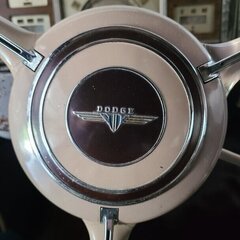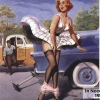
Eneto-55
Members-
Posts
1,906 -
Joined
-
Last visited
-
Days Won
5
Eneto-55 last won the day on March 9
Eneto-55 had the most liked content!
Reputation
323 ExcellentProfile Information
-
Gender
Male
-
Location
United States
-
Interests
P-15, RatRods, Mini Cycle Cars
-
My Project Cars
1946 Plymouth
Contact Methods
-
Biography
Born 1955
-
Occupation
self-employed
Converted
-
Location
Ohio
-
Interests
1946 Special Deluxe
Recent Profile Visitors
The recent visitors block is disabled and is not being shown to other users.
-
Looks like someone's motto was "Use what ever is handy." Reminds me of my grandpa. He was born in 1893, and was possibly the only one of the children who was born in North America. Anyway, he served non-combatant in WW I, as a carpenter. He was stationed in Virginia, and they were building airplane hangers. (There was no 'Air Force' yet - I think it was the army.) He rode the beams up & fastened them in place. Before WW II he owned some rental houses in our closest small town, where there was a brick factory, so lots of workers who often didn't stick around very long. Then the brick yard closed, and he couldn't afford to pay the property taxes. So he let it all go to the government, but first he took parts of those houses and attached them to their farm house. His mother came to live in a section he had added to their house, but you had to go outside to get into it, which, as I understand from my Mom, suited Great Grandma just fine. Then in 52 he sold the farm and built a new house on the property where I grew up (on one corner of the farm). I was only up in the attic of that house once, and there was all sorts of old beams he had used, stuff he's saved from who knows where. Your picture reminds me of the way his attic looked.
-
My brother-in-law, a licensed electrician, prefers to wire lights with the switch on. That way he doesn't have to get off of the ladder to test it.... (110 doesn't bother me, either. I often wire stuff while it's hot.)
-
This stuff looks like it's made of shredded cardboard. It doesn't itch, but it coats me and my mask with looks like good old dirt. (And some of it is so fine that gets through or around the mask, and so I blow mud out of my nose afterwards. My glasses get fogged up too, and the dirt gets caked on the inside of the lenses.) This 12 VDC system uses regular 120 AC bulbs. The 12V deal apparently used capacitors or relays to turn the lights on and off. I haven't tested one of these switches, but the appear to be double momentary switches - push up for momentary ON, and down for momentary OFF. That is, the switch does not stay in the position (up or down) that you last pushed it.
-
Sounds like I'm not the only one who had used the emergency brake for stopping at higher speeds.....
-
Eneto-55 started following experienced trunk lid rubber seal buyers ? and House Renovations - Questions
-
Leaving this general, because I'll probably be back with questions in other categories. This time, blown insulation vs bat, and electrical: hot wire to light, or to the switch We have purchased the house where my wife grew up from age 12 until we married. Built in 1965, blown insulation. It is a real pain to deal with. It's dusty, and moving any of it to trace electrical wiring or do any other work up in the attic creates a cloud of fine dust. The house was originally all electric, with base board heaters. Her dad later installed central heat & A/C. Removing the base board heaters, thermostats, and wiring. (So it will not be so confusing - many of the breakers are not labeled, and I don't know if something I would consider a no-no might have been done - branching off of the 220 circuit at the heater to supply 110 to other devices. Unfortunately, I have some suspicions along this line.) I also removed two weight-bearing walls, so I had to do a lot of work in the attic, installing over-head beams. Now I'm mostly trying to trace wires. There is also a 12 VDC system integrated into the lighting in various locations in the house. The lights themselves are not DC, only the switching control system is. The light bulbs are all 110 AC. Not sure if parts are still available for something like that, so maybe we should replace it now? Powering a light - service connected at the fixture, or at the switch? Back home, the power always went to the switch (at least I'm pretty sure of this). In our current house, some service lines go to the light, others go to the switch. You don't know until you open it up and touch the terminals. (Yeah, I know, there are other ways, but none are so 'exciting'.) I've looked on-line, and there is (of course) little agreement. Some say that power to the light used to be common, because it uses less wire. Then some say you can still do it according to code in most places, but that power to the switch is now 'preferred'. Others say power to the fixture is no longer per code, and that if you do any electrical work in a house you are required to switch everything over to the, well, the switch. Others add that some modern light switches need power all of the time, so they won't work unless you power the switch. (What kind of devices would that be?)
-
I should have told in what area of the engine harness I found broken wires - the reason I mentioned strand count is that the broken wires were in the areas between the engine and the firewall, or other places where they crossed from the engine to the body. That is why I did the strand count, because I was assuming that the damage was due to flexing. But the harness wrapping in those areas, and also the wire insulation itself, that was all very stiff, from the heat, I would suppose. So any shields you can fabricate would probably be a good idea.
-
That coincides with what I found when I unwrapped the engine wire harness from the 93 T&C I scrapped out - various wires were broken, or so nearly severed that contact might have been intermittent at best. (In comparison to the wire on my P15, the strand count for a similar gauge wire is much higher on the old vehicle. I wonder when vehicle manufacturers started using lower strand-count wire, and if it was a slow transition.)
-
Turn Signal Housing 3 D Scan File
Eneto-55 commented on Conn47D24's file in Instructions, Manuals & Templates
-
This info might be in the book in the download section (Plymouth Revised Condensed Master Parts List D-12678), but I never saw it there. (That's the book given to me this past Christmas, when I put the book Standard Parts List D-11171 on my Christmas list.) Then I bought the book (on ebay, rather poorly described) Plymouth Parts List Series P15 D-12198 (also on ebay, and so vaguely described that I thought that IT was the elusive D-11171). Anyway this latter 'mistake' has give me the official conclusive answer to my questions about the size of the PLYMOUTH hinge pins. (Plymouthy Adams had long ago stated that the Dodge book gave the size as 5/16", but I still wondered if the hinge tongues on all of the cars that people were reporting on, after having measured the hinge pins as 11/32" (like mine, which I measured with a micrometer, as I think most others had also done), had really all been reamed out. Apparently so. It must have been a very common problem to have sagging doors after some years of opening & closing them. So here is the part of the page for hinge pins, in the Parts List book that is specifically (and only) for the P15 model: (I hope this helps others who are still wondering about this question.)
-
Plymouth Passenger Car Parts List Model Series P15
Eneto-55 replied to David T's topic in P15-D24 Forum
I recently bought one of those same books, thinking I was getting the D-11171 manual. The descriptions on epay are often not accurate, using titles that are not what is actually on the cover. Anyway, this one is specifically just for the P15, so it doesn't have all of the stuff for the earlier models, to confuse the reader. (Or at least that's how I'm trying to "put a positive spin on it", since I now have both of them.) I actually started in on thinking I "need" this book just to confirm the hinge pin size on the Plymouths..... But I still don't have a shop to work in, and now we're doing major repairs and remodeling on my wife's dad's house. (He passed away 4 years ago now.) It started out as just somewhat major remodeling - moving some weight bearing walls, that sort of thing. But now we're finding lots of rotted out walls, with LOTS of rodent 'show' inside the walls and about everywhere. (I told my wife's cousin's husband some years back that you have to 'think like a mouse' while you are building if you want to keep them out, but he said it's impossible. I haven't had an opportunity to try, so I still disagree. But having an attached garage does make it nearly impossible, unless you really concentrate on keeping the attics of the house and garage completely blocked off in between Sorry for going on about my problems here..) -
Eneto-55 started following Parts Info Bulletin # 37 (Dec 10, 1948)
-
-
The only mention I found about steel camshafts was in the topic called “Clothespins not what they used to be?”, where ... On 7/5/2010 at 5:41 PM, Plymouthy Adams said: Only a steel camshaft will bend, cast iron will break there was a number of steel cams used. The suffix S will be affixed to those engine serial number that indeed came stock with a steel camshaft. The cam bearing supports as close as they are to each other would petty much prevent any bending. A cast cam shaft that is laid at an upright angle would have a tendency to warp due to shift. Only by v-blocking will you be able to detect and measure the runout.
- 1 reply
-
- camshaft
- oil pump drive gear
-
(and 2 more)
Tagged with:
-
Recently purchased another P15 manual, and this Parts Info Bulletin was stuck in the engine section. The issue is steel vs cast iron engine parts.
- 1 reply
-
- camshaft
- oil pump drive gear
-
(and 2 more)
Tagged with:
-
I know I'm probably way behind the times on this, but .... Well, I looked it up on-line. Imron doesn't appear to have a chrome paint.
-
LC, Sorry for the loss of your brother and sister.






.thumb.jpg.6f4d73bb13ef4cecf6cfb4b60b7bcb69.jpg)
.jpg.8a97c2fcd6b0b11c8a3d8df2d0157665.jpg)